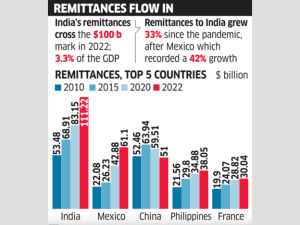TAG: GS 2: INTERNATIONAL RELATIONS
THE CONTEXT: India received over USD 111 billion in remittances in 2022, the largest in the world, becoming the first country to reach and even surpass the USD 100 billion mark, as per the reports.
EXPLANATION:
- The International Organisation for Migration (IOM), in its World Migration Report 2024, said that in 2022, India, Mexico, China, the Philippines and France were the top five remittance recipient countries.
Highlights of the Report:
- In 2022, India remains the top remittance recipient country, receiving more than USD 111 bn, the first country to reach and even surpass the USD 100 bn mark.
- Mexico is now the second largest recipient of international remittances in the world after India.
- China had long held the second spot but it was surpassed by Mexico in 2021, with the Central American country estimated to have received more than $61 billion in 2022, while China received about $51 billion.
- “The contraction of remittance flows to China has been attributed to multiple factors, including demographic shifts that have resulted in the shrinking of the working age population and the country’s zero-Covid policy, which prevented people from travelling abroad for work,” the report said.
- International remittances surged by 650 per cent, from USD 128 billion to USD 831 billion between 2000 and 2022.
- Migrant remittances surpass foreign direct investment in boosting the GDP of developing nations.
- 281 million international migrants globally; number of those displaced hit a record high by the end of 2022 at 117 million.
- The significant rise in remittances reflects the substantial contribution of Indian diaspora worldwide to their home country’s economy.

Remittances of India crossing $100 bn.
- Southern Asia, including countries like India, Pakistan, and Bangladesh, receives substantial inflows of remittances, underscoring the importance of labor migration from this subregion.
- This highlights the reliance of these countries on remittances as a crucial source of income.
- The report also highlighted that nearly 18 million or 1.3 per cent of the total population, India is also the origin of the largest number of international migrants in the world, with large diasporas living in countries such as the United Arab Emirates, the United States and Saudi Arabia.
- India came in 13th as the destination country for immigrants, with 4.48 million. India – United Arab Emirates, India – US, India – Saudi Arabia and Bangladesh – India were among the top 10 international country-to-country migration corridors, the report said.
Challenges Faced by Migrant Workers:
- Despite the economic benefits, migrant workers face various risks such as financial exploitation, excessive debt due to migration costs, xenophobia, and workplace abuses.
- The Gulf States, significant destinations for migrant workers, exhibit high proportions of migrant populations, indicating their reliance on foreign labor.
International Student Mobility:
- Asian countries, particularly China and India, are major sources of internationally mobile students.
- The United States remains the top destination for international students, followed by the UK, Australia, Germany, and Canada.
Gender Disparities in Migration:
- Female migrants outnumber male migrants in destination countries in Europe, Northern America, and India.
- Countries like India, Bangladesh, and Pakistan exhibit a significantly high proportion of male emigrants.
Challenges of Irregular Migration:
- Irregular migration to the US remains a significant challenge, with a notable increase in arrivals from atypical origin countries.
- The impact of policies like Title 42 and the COVID-19 pandemic reshapes migration patterns and origin country geography.
Impact of the COVID-19 Pandemic:
- The pandemic has disproportionately affected internal and international Indian migrant workers, particularly those in low-skilled and informal sectors.
- Job losses, wage theft, and lack of social security have led to increased debt and insecurity among Indian migrants.
Reshaping of Labor Mobility:
- The pandemic has reshaped labor mobility, with a decline in blue-collar workforce mobility towards cities and a significant percentage of reverse internal migration.
International Organization for Migration:
- Established in 1951, IOM is part of the United Nations System and stands as the leading intergovernmental organization in the field of migration.
- With 175 member states, a further 8 states holding observer status and offices in 171 countries, IOM is dedicated to promoting humane and orderly migration for the benefit of all.
- It does so by providing support to migrants across the world, developing effective responses to the shifting dynamics of migration and providing advice on migration policy and practice.
- Its headquarters are located in Geneva, Switzerland.
- IOM’s work is focused on the following three objectives:
- Saving lives and protecting people on the move: To fulfill this objective, IOM puts the safety, dignity and protection of people first in the most challenging crisis response contexts in the world.
- Driving solutions to displacement: In response to this aim, IOM endeavors to reduce the risks and impacts of climate change, environmental degradation, conflict and instability for communities affected by or at risk of displacement.
- Facilitating pathways for regular migration: To address this pursuit, IOM prioritizes whole-of-government, whole-of-society approaches to safely connect people, goods, services, knowledge and innovation.

